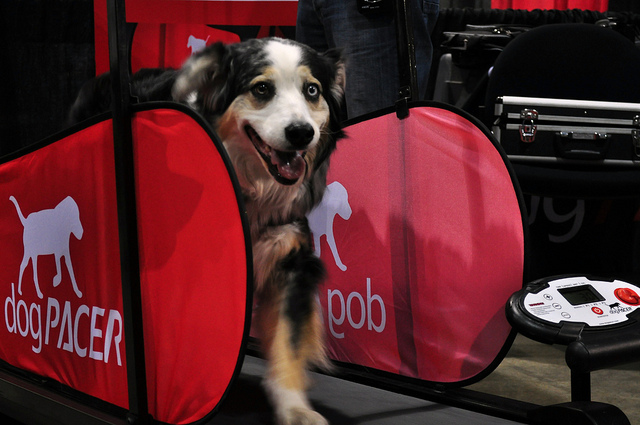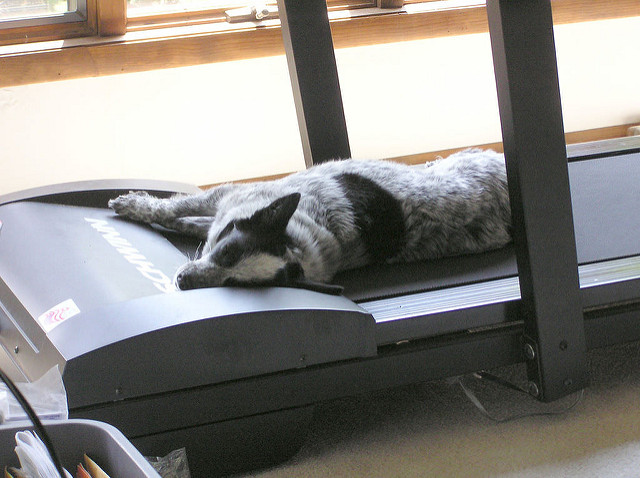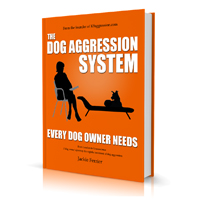
Photo Credit: Roxanne Ready
There are many reasons to use a dog treadmill: poor mobility in dog owners, physical rehabilitation for dogs, humidity and heat, cold, ice and painful salt on sidewalks. Or perhaps your dog just has an abundance of energy. A treadmill may be just the thing to add to daily outdoor walks.
But there is probably no greater need for a dog treadmill than by an owner who owns a reactive, anxious or aggressive dog.
We know that exercise promotes not only physical well being but also mental well being.
Respected animal behaviorist and scientist James Serpell suggests that because dogs cannot get time off leash, the amount of exercise dogs get is limited to two off leash walks a day. He believes this is a contributing factor as to why so many dogs develop behavior problems. (1)
Dogs also like to get a tremendous amount of exercise. They’re very active animals. And in my community here in the US it’s actually illegal to let your dog off the leash unless it’s in a confined space, in a dog park essentially, and most people don’t have access to that, which means that your average dog gets walked around the block on a leash twice a day. And that’s really inadequate in terms of exercise. And I think this is the explanation, or at least a partial explanation, for why so many of these dogs develop behavioural problems. They’re just simply not exercised enough.
James Serpell on the Domestic Dog
A lack of exercise can contribute to stress and this is a key concern for any dog owner who has a dog that suffers from any kind of anxiety, fear or aggression.
But depending on where you are walking your dog a dog walk may even make things worse, if you are unable to avoid the triggers that may set off anxiety or aggression on walks such as loud traffic, strange people or other dogs.
So we are set with a dilemma. Do we avoid exercising our dog to avoid contributing to their (and often ours when we run into bad encounters with others)? Or do we take the chance, hope that we have an incident free walk and hope that the exercise will have a benefit in lowering stress levels.
How to exercise a dog and minimize stress contributing to behavior problems?
Generally we recommend that before we start a treatment program for chronically stressed dogs, we do everything we can to lower stress in general. If that includes walks, that we recommend eliminating them – but only temporarily. Only until a dog’s – and dog owner’s – equilibrium can be returned as much as possible back to stable levels.
However by doing so we are not taking advantage of all of the benefits that exercise can provide are in terms of reducing them reducing stress and helping them cope. A variety of studies across species have shown that exercise can reduce anxiety and stress.
One solution may be to exercise your dog in your home. A treadmill is not the only way to do this. There are exercises you can do to get your dog moving up and down stairs and from room to room such as using targets, or playing hide and seek. You can use “flirt poles” in the back yards as well. But with particularly active dogs, or with dogs that may be restricted from walking outside for a number of days, using a dog treadmill in the short term by be a solution.
Exercise is not the only benefit of a dog walk
It should be noted that a key benefit of taking your dog outside for a walk, are the many benefits they get from novelty and being able to interact with their environment with their nose. This is so important and of value dto dogs that research has indicated that dogs tend to favour those that walk them moer than anyone else that interacts with them (including those that feed them).
Now obviously if going for a walk causes more stress than anything else the dogs are gaining very little by being outside on their walk. We can’t forget that we can’t see how unpleasant it is to be anxious.
However that doesn’t mean that dogs don’t need and benefit environmental enrichment. Spending all day in a confined area with little to do is day in and day out flat-out boring!
So, if you are considering using a treadmill to exercise your dog (even if you are not), you should also consider other ways to enrichment their worlds, such as scent training that encourages your dog to work use their nose. You will also find that when their minds are actively engaged the need for exercise is reduced a little.
What kind of treadmill is best for dogs?
Treadmills are not cheap and can run upwards as much as $2000. You might want to decide if you you will be using it as well. If not, finding one suitable for dogs might be the best choice and you can likely find a new and reliable one especially designed for dogs for $600 or less.
The kind of treadmill you choose partly depends on how you want to train them, the size of your dog.
The most important aspect (other than noise) is using a treadmill that accommodates the natural gait of your dog.
Human treadmills may be acceptable for smaller dogs provided they are on the quiet side and that they can go slow enough. You just want to watch out for any gaps, or caps where toe nails could get caught and make sure that you keep the motors free of dog hair. There are a variety of treadmills on treadmills on Amazon you could review just to get a sense of what is available.
If you have a larger dog, you probably want to go with the dogPACER for larger dogs (see on Amazon – this is an affiliate link but we only include it for viewing only – please find a treadmill that suits your dog). There are dogPACERS for smaller dogs. They are included here as they are relatively well reviewed, can be purchased through Amazon and they are fairly quiet, and their motors are protected against dog hair. They tend to run between $500-$600 at the time of writing.
Human treadmills are often not recommended for pets by the manufacturer and may void your warranty. But if you already have one that you want to make sure that it is long enough to accommodate the natural walking or trotting speed and gait of the dog (and ideally stops slowly). As dogs tend to “float” from side to side as well and forward and backward as they get used to the treadmill so many humans treadmill are too short and too narrow for larger dogs.
You also may want to look into picking up a used one. Be sure to make sure it’s long enough for your dog, it can support the weight of your dog and is relatively quiet.
Training a dog to use a treadmill
A treadmill is not a natural apparatus for a dog to use. Many dogs are afraid of just the sound of a treadmill never mind getting on one. And almost every dog will need some time to learn how balance on it and learn to walk on it.
Your first step is getting your dog comfortable around it.

How you teach a dog to use a treadmill is of particular importance especially when it comes to reactive, anxious or aggressive dogs. You should only use positive methods, no corrections, it should not be rushed and it should only be a positive experience.
The following video shows one method of getting your dog to use a treadmill that i completely voluntary and force free. Note how comfortable and willing the dog is. They key here is moving only at the dog’s pace and keep the treats coming!
In the following video the dog looks a little less comfortable based on the position of the ears. However, this dog has been injured and this may be a factor.
Because of the side bars of this particular treadmill, the dog does not get the benefit of being able to place just a few paws on the moving belt the way the dog gets to in the previous video. The more you can break down a process into smaller chunks the easier it is on the dog.
Tips and Warnings
A couple of warnings here. You are not going to be able to flip on the TV while your dog is exercising in the background.
- Never leave unattended
- Should not be substituted for mental enrichment
- Keep your dog interested
- Train for only short periods of time
- Do not use leashes or harnesses to force your dog on or to keep your dog on the treadmill
- Do not over-exercise young dogs under the age of two as they can do long term damage to their joints
- Dogs are better off walking or trotting than running
- Do not exercise for more than 30 minutes (may be less depending on the dog)
Do not use a leash or a harness when training a dog to use a treadmill
Why is this important?
You will see a number of videos teaching your dog to use a treadmill through using force, leashes, etc. But this is not a good choice for reactive, anxious or aggressive dogs. Dogs should feel in control and comfortable that they can get off the treadmill at any time.
Value and enjoy the process!
Dog owners are often guilty of rushing their dogs through a learning process. But remember, the key here is to improve your dog’s well-being as well as getting exercise. Enjoy the process!
There may be even more benefits in this learning process for your dog than actually using the treadmill.
That’s because there is novelty, there is engagement with their human(s), and if you use only positive methods and allow them some control in how fast they learn and whether they want to get on or off the treadmill, the learning experience can be very enriching.
Be patient. Keep your expectations in check and this will keep your frustration low or non-existent. Use this time to observe how your dog learns and deals with novel experiences. Dog should never be rushed into handling more than they can handle. No one enjoys that. But you will find by using positive only techniques can make the experience positive and interesting for both you and your dog.
Teach your dog to relax
Finally a key component in treating anxiety is to teach our dogs to relax. We can to teach them what it feels like to relax and then how to relax on cue. Without being able to relax, our work using desensitization and operant conditioning is unlikely to succeed.
Keep in mind that if our dog are chronically stress, are dogs may have difficulty with this. It may require time away from their stressors (like a vacation for us), or they may need medication if stress and anxiety is a deeper problem.
NEXT
Listen to James Serpell on the Domestic Dog
For more
Reference:
(1)


